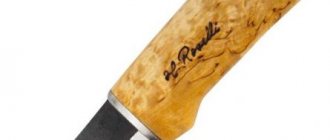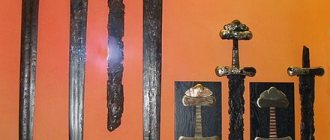Battle axes: an excursion into history
Date of publication: March 14, 2020 at 18:23
Battle axes found by the author
Inspired by the recent discovery of a battle axe, I decided to write a lengthy article about battle axes: their characteristics and use in different eras of time. And it’s up to you to decide: is such a find a rarity for a treasure hunter or just “garbage”?
The influence of Viking weapons on Slavic warfare
Many similar weapons were found during archaeological excavations in our country. Brodaxes are especially common, and such finds are most typical for the Leningrad region. Around the 12th-13th centuries, the situation in those parts became less “tense”, and the list of standard weapons gradually changed. Viking axes with wide blades are gradually “transformed” into relatively harmless household tools.
By the way, according to historians and archaeologists, it was during the period of maximum distribution of Brodaxes in Rus' that a real “boom” in the development of domestic weapons thought of those years occurred. Battle axes in Rus', created under the influence of the Varangians, absorbed all the best from European, Asian and Scythian samples
Why do we pay attention to this? It's simple: the evolved Russian axes will later appeal to the descendants of the Normans
How did battle axes appear?
To write about battle axes, let's understand such a concept as an ax , and only then we will move directly to battle axes . I think if you ask any person on our planet what an ax is, everyone will give an answer, since the ax is still used today on all continents of our planet, from civilized countries to tribes living in Africa or Australia.
The first axes of the Paleolithic and Neolithic eras
The history of the ax dates back to Paleolithic times, when the first stone axes appeared. Ancient people gave the stone the appearance of a blade and used it for various purposes. If it was possible to butcher killed animals with a primitive ax, then cutting down a tree or going hunting with such a weapon was difficult.
And the ancient man came up with a way to fasten a stone ax to a stick using a strong vine or dried animal veins. This is how the first battle axes appeared, with the help of which an ancient man could go hunting or protect his tribe.
During the Neolithic period, with the development of ancient man, the battle ax also developed. The stone was ground, which gave it smoother surfaces, and holes were made in the stone to better secure the ax.
A new impetus for the development of battle axes was given by the Copper Age, which includes approximately the period of time from the 4th to the 3rd millennium BC. While selecting stones for processing, man encountered copper for the first time.
While processing the stone, hitting it with a stone, pieces did not break off, but on the contrary, the stone became deformed, changed its shape, and this is how the first “ cold forging ” appeared. Although the first copper was found in its raw form, stone axes were used for a very long time, even into the Bronze Age.
Read on "E-KLAD": Coping in winter: Scythian ax
Basic information
Contrary to popular belief, Viking axes, even the most menacing in appearance, were never heavy. Maximum – 600 grams, no more. In addition, the shaft was never bound with iron! Firstly, metal used to be extremely expensive. Secondly, it made the ax heavier, and a massive weapon in a long battle could lead to the death of the owner.
Confirmation of this is the found graves of military leaders and high-ranking “philistines”. Sometimes entire arsenals were found in them, including many axes. So this weapon is truly universal; it was used by both ordinary soldiers and their commanders.
Battle ax
Battle axes from different eras
A battle ax is one of the branches of a simple ax and is intended for inflicting wounds or mutilation on a living organism, be it a person or an animal. The battle ax can be divided into two parts: the blade and the axe. Since the warrior had to fight for a very long time in battle, the weight of the battle ax was relatively light.
The weight of the blade varies from 150 grams to 500 grams, and the shaft or ax handle is about 400 grams. The approximate weight of the ax was about one kilogram. Depending on the length of the axe, battle axes were divided into one-handed and two-handed . If one-handed axes had a handle from 50 cm to 120 cm, then two-handed axes reached the height of an average person.
Due to their versatility, battle axes were both single-sided, since the back was flat, and double-sided, with a blade on both sides. For a foot warrior, a battle ax was the main weapon in close combat, but a warrior could also throw an ax at the enemy, everything depended on the skill of wielding the weapon.
The horsemen used the battle ax as a secondary weapon, since while galloping it was difficult to strike the enemy. Having a small area of destruction, the battle ax gave birth to such military weapons as: halberd, berdysh, polex and others. During battles, warriors compensated for the small area of the blade with the power of a penetrating blow due to the light weight of the ax.
Since metal was rare in ancient times, battle axes prevailed over weapons such as swords, so the ax was easier to make, less metal was spent and the ax was much more functional than a sword. For their functionality, battle axes are in demand all over the world, which has given rise to many varieties, such as:
Wallashka Sagaris Franziska Mint Celt Tomahawk Lochaberakst Ax Brodex and others
Read on E-KLAD: Battle axe, a rare find
Valashka
Battle ax of Valashka, Carpathian tribes
Wallashka's roots come from the Carpathian region. Translated from Slovak - Valashka; from Hutsulsky - Bartka; from Hungarian - Fokos; in the mountaineers gural - Tsyupagi. And this is not the entire list of tribes living in the Carpathian region, which accordingly have their own names for the battle ax. The battle ax is very similar to a cane; it is light, thin, about a meter long.
The blade of the Valashka ax is only 7 centimeters on one side, and on the other there is a flat, blunt surface like a hammer. The versatility of the Valashka made it possible to hit like a simple stick; the flat surface was often used as a hammer, and the blade itself was used to chop down both wood and enemies.
Due to its functionality, the Valashka ax was in service with many local robbers living in the Carpathian region. Many axes were carved, decorated and inlaid with precious metals, which symbolized the wealth and dignity of the owners of such an ax.
With the development of technology, Valashka began to be improved with various devices, for example: a dagger was hidden inside the ax handle, since the handle was long and hollow, even a sword was placed there and if you shook it strongly, it flew out like a dart. But the best adaptation to Valashka is considered to be a cricket, a mixture of a pistol and an ax, where the shaft was used as a barrel, and there was a barrel at the end of the blade.
Sagaris
Battle ax Sagaris, favorite ax of the Scythians and the Persian Empire
Sagaris has its origins in the Middle East. Many believe that Sagaris is primarily Scythian in origin, but it would not be lying if he said that he was a Persian axe. Like all battle axes, Sagaris consists of a blade and a shaft.
The blade of the ax was elongated on one side, and on the other, a pointed, curved, heavy butt also acted as a counterweight, and the shaft was thin and long. The blade had many different shapes. The weight of Sagaris allowed it to be used with one hand very effectively, striking with Sagaris, the warrior would penetrate any armor or protective helmet in use at the time. Due to its weight, the battle ax was used by both cavalry and infantry.
For the more noble Scythians, images of different animals were painted on the ax blade. Leading a nomadic lifestyle, the Scythians spent most of their lives raiding and fighting other tribes, which allowed them to improve their weapons with each campaign. The functionality of Sagaris and constant nomadic life, the ax very quickly spread throughout the Middle East, and became an integral part of the Persian warrior.
Over time, as more new territories were conquered, the Persian Empire extended the use of Sagaris to the Sarmatian-Alanian tribes. Which, in turn, spread the battle ax to the West, and then to Eastern, Central and Northern Europe.
Franziska
Battle ax of Francis, an integral attribute of the Germanic and Frankish tribes
Francis takes the history of her origin from the Frankish and Germanic tribes. Since these tribes practically did not use cavalry, Francis was used in two ways.
The first method made it possible to put a blade with an elongated nose on a meter-long shaft, so that you could chop the enemy while holding a battle ax in one or two hands. At the end of the shaft there was a thickening, which made it possible for the battle ax not to slip out of your hands during intensive chopping. The barbarian with Francis was very maneuverable and fast, which allowed him to deliver a large number of blows, crushing both the heads and cutting off the limbs of the enemy.
The second method made it possible to throw Francis at the enemy; for this, the blade was put on a shaft not exceeding the length of an arm and a rope was tied at the end of the shaft. In case of failure, the ax could be returned and thrown again. Such an ax was worn on the belt for convenience, which made it possible to quickly take it out and throw it. The affected area from such flying axes was 12 meters.
The power of Francis was felt by the soldiers of the Roman Empire when they first encountered these barbarian tribes. Even before their shields collided with each other, many Roman soldiers fell to the ground from the Francis skillfully thrown at them, which forced the Roman Empire to reconsider its concept of using battle axes.
Due to its functionality, Francis became the main weapon of the Franks and Germans, since its manufacture did not require the use of expensive steel at that time. Excavations of many burials have proven that Francis was in service not only with an ordinary warrior, but also with many leaders and military commanders.
Mint
Battle ax Minted, which came to Rus' from the East
The Chekan ax has Slavic roots, although it was inherited from the East. The coin is divided into a shaft not exceeding 100 centimeters and a blade in the form of a beak on one side and a flat butt elongated in the form of a hammer.
This placement of the blade had good balance, which allowed the warrior to deliver very accurate blows. Thanks to its beak, the hammer pierced armor, and due to its characteristic shape it was easily pulled out even from a wooden shield, and did not get stuck like most battle axes.
The design of Chekan allowed it not to slip or ricochet when striking a warrior’s armor, but to cause maximum damage. This design of the battle ax allowed it not to bend and break when striking the enemy’s metal defense. Weighing up to 400 grams, the warrior easily used the Chekan, both in battle and in cutting down trees if he had to go through dense thickets. Due to the beveled part of the blade downwards, the Chekan was used both with chopping and cutting blows.
The Chekan ax served as a badge of honor in Rus', allowing one to determine that the owner of the ax belonged to the military class. Chekan also had “brothers” very similar to him, such as the Polish Najak and Klevets, also common in Rus' and Europe. The difference between Chekan and Klevets field gala is that Klevets got stuck in everything he was driven into.
Brodex
Brodex battle axe, the favorite ax of the Vikings
Brodex is considered the brainchild of Francis, which was used by Germanic and Frankish tribes. Brodex was most widespread in Northern Europe. If Francis was used in the 5th - 7th centuries, then Brodex was used much later than the 10th - 11th centuries.
The Brodex ax is very similar to an ax with a wide trapezoidal blade on one side and a rectangular head and beard on the other. This is where the name broad-bladed or beard-shaped ax came from, since the blade was similar to a man’s beard. The blade itself had rounded corners, the transition between the blade and the butt of the ax was very thin.
But there were Brodexes and those that had a blade on both sides, but such battle axes were ineffective, since they had a narrow range of specialization due to their inconvenience and were called the Danish ax. Many believe that Brodex was the Vikings' favorite battle axe. With the use of cavalry in battles, the use of the ax decreases, since it was ineffective against cavalry.
But later, with the advent of well-protected knights, Brodex again became relevant, since it was not possible to defeat a knight with a sword, but heavy Brodex did it with ease. In order to make it clear that the owner of the ax was a wealthy person, decorations with silver inlay were applied to Brodex. Since the tribes led a nomadic way of life, moved and traded with other tribes, in Rus' Brodex became the predecessor of Bardysh.
Ax of Perun
In addition to the fact that the ax was an excellent weapon in battle, its shape was even used to make amulets. One of them was called “Perun’s axe” and was an ax with a pair of sharp blades attached to a small shaft. The ax was worn as a talisman on the chest or on the belt. Usually the material for the talisman was iron, bronze or lead.
He used his constant attributes: lightning arrows, a spear, an ax and other weapons. Perun's ax was considered the most victorious weapon, which he used in countless battles. One legend tells of a battle with the Serpent, in which Perun managed to restore the presence of daylight with his weapon. Following these events, the ax began to be revered as the personification of victory.
Author of the article:
Boguslavsky Sergey
I am a former military man, an officer, and military topics are close to me, I can easily navigate them.
Why not a sword?
As we have already noted, the ax is often perceived by the average person as a weapon of a lumberjack and owner, but not of a warrior. Theoretically, this assumption has some logical premises: firstly, these weapons are much easier to manufacture. Secondly, even more or less tolerable mastery of the sword required at least ten years, while the ax was with a person constantly in those days, and improvement in the skills of its use occurred, so to speak, “on the job.”
Most likely, in historical perspective, the ax gave way to its place due to advances in metallurgy. There was more steel, warriors could be provided with a large number of albeit inferior, but technologically advanced and cheap swords, the technique of combat use of which was much simpler and did not require such significant physical data from the “user”. It must be remembered that the fights of that time were by no means elegant fencing, the matter was decided by two or three blows, the better prepared person had the advantage, and therefore both the ax and the sword in this regard were weapons of equal value.
Other notes
As you can see, making a Viking ax with your own hands is relatively easy, and it won’t require much expense. The disadvantage of this method is that the resulting tool will only have a decorative function, since it will no longer be able to perform household work.
To create an authentic sample, you will have to use the help of a professional blacksmith, since only forging will allow you to get a truly fully functional ax, an analogue of the axes that the Vikings once fought with. Here's how to make a Viking axe.
Sacred meaning
There is another circumstance that indicates the respect with which the northerners treated axes. Archaeological and written sources clearly indicate that the Viking “axe” tattoo was extremely common in the period from the 10th to the 15th centuries. This weapon, one way or another, appeared in almost all the combat patterns with which professional warriors decorated their bodies.
It is also worth noting that the Viking Ax amulet was no less common. Almost every second neck pendant included a miniature figurine of an axe. It was believed that such decoration bestows the strength, power and intelligence of a real warrior.











